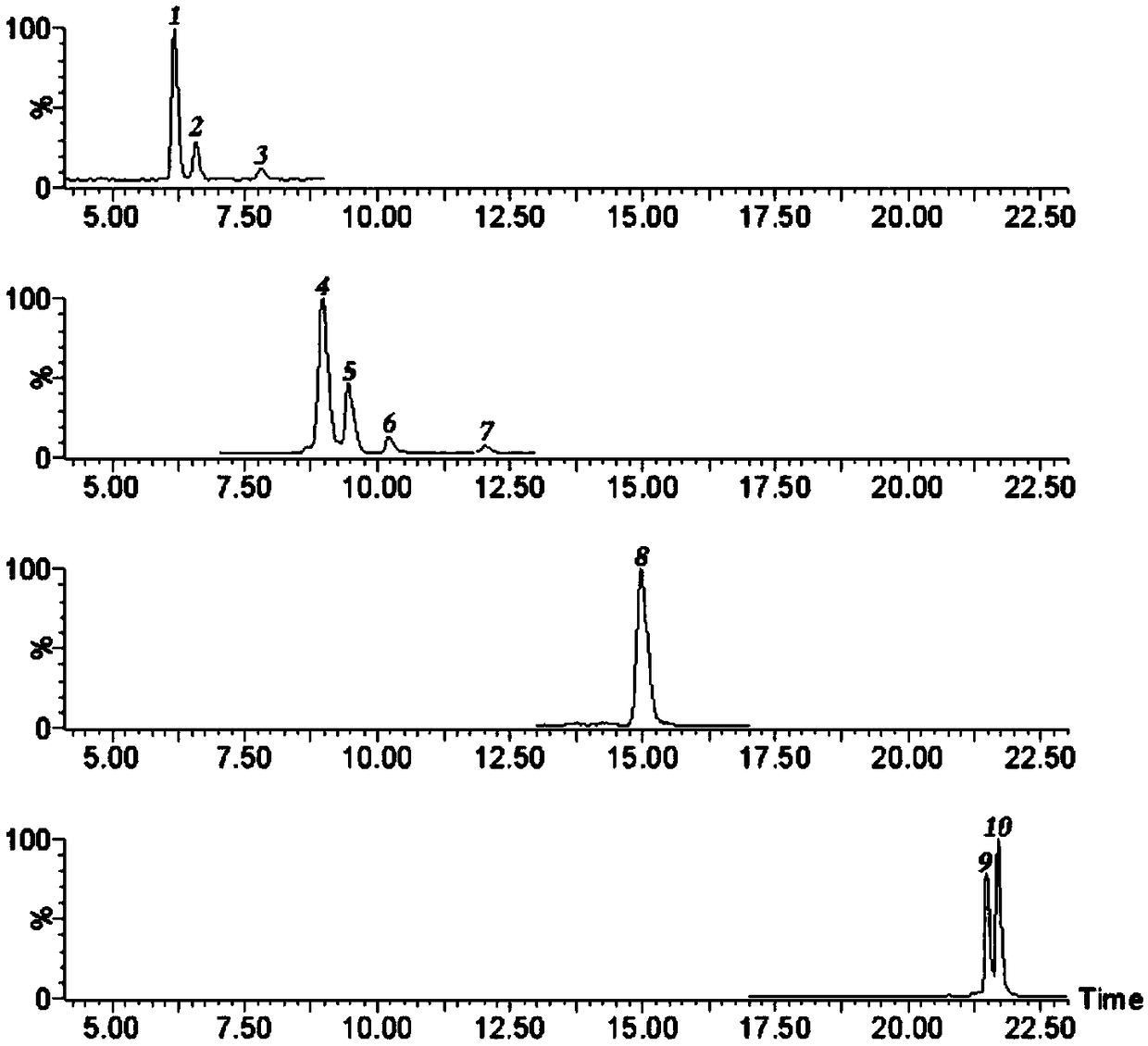Method for directly detecting tea glucoside combined state aroma precursor substances
A technology of precursor substances and combined states, which is applied in the direction of measuring devices, instruments, scientific instruments, etc., can solve the problems of low flux, incomplete enrichment, cumbersome extraction and purification process of precursor substances, etc.
- Summary
- Abstract
- Description
- Claims
- Application Information
AI Technical Summary
Problems solved by technology
Method used
Image
Examples
Embodiment 1
[0048] Embodiment 1. A method for directly detecting tea glycoside-bound aroma precursor substances, the following steps are carried out in sequence:
[0049] 1) Extraction of glycoside-bound aroma precursors in fresh tea leaves:
[0050] Harvest new shoots with 1 bud and 2 leaves in spring of 'Zhenong 113', use a hole puncher with a diameter of 0.5cm to punch holes in the harvested shoot leaves, weigh a leaf disk equivalent to 0.1g dry weight, and place In the homogenizer, add 10mL of pre-cooled (-5°C) 95% methanol and mix, then homogenate for 10 minutes at a speed of 1200-2000r / min (low speed can be used for young samples, and high speed can be used for coarse and old samples) , transfer the homogenate to a 50mL centrifuge tube, centrifuge at 5000r / min, 4°C for 5min, absorb all the supernatant and transfer to a new centrifuge tube; mix the residue with 10mL pre-cooled methanol (-5°C) again, and sonicate (40W) Extract for 20 minutes, centrifuge at 5000r / min at 4°C for 5 minu...
Embodiment 2
[0072] Embodiment 2, a method for directly detecting tea glycoside-bound aroma precursor substances, the following steps are carried out in sequence:
[0073] 1) Extraction of green tea glycoside-bound aroma precursors:
[0074] Grind the Maofeng green tea sample with a sample mill, pass through a 60-mesh sieve, weigh a sample equivalent to 0.05g dry weight in a 50mL centrifuge tube, add 10mL pre-cooled (-5°C) 90% methanol ultrasonic (40W) leaching After 20min, centrifuge at 5000r / min, 4°C for 5min, transfer all the supernatant to a new centrifuge tube; extract the residue again with 10mL pre-cooled 90% methanol ultrasonic (40W) for 10min, and centrifuge, absorb all supernatant, combine 2 supernatants; add 3.0 μL of 4-nitrophenyl-β-D-glucoside (1 mg / mL) as an internal standard to the combined supernatant, add 0.2 g of insoluble polyvinylpyrrolidone pre-swelled with ultrapure water PVPP, mix well to precipitate polyphenols, let it stand for 60 minutes, centrifuge at 10000r / min...
Embodiment 3
[0080] Embodiment 3, a method for directly detecting tea glycoside-bound aroma precursor substances, the following steps are carried out in sequence:
[0081] 1) Extraction of aroma precursors in the glycoside-bound state of Oolong tea:
[0082] Sampling the shake green leaves in the process of oolong tea processing, weigh the shake green leaf samples equivalent to 0.1g dry weight, place in a homogenizer, add 10mL pre-cooled (-5°C) 95% methanol homogenate for 20min, Centrifuge at 5000r / min, 4°C for 5min, transfer all the supernatant to a centrifuge tube; mix the residue with 10mL pre-cooled 95% methanol again, and extract with ultrasonic (40W) for 20min, centrifuge, absorb all the supernatant, and combine twice supernatant; add 3.0 μL 4-nitrophenyl-β-D-glucoside (1 mg / mL) to the combined supernatant as an internal standard, add 0.1 g of insoluble polyvinylpyrrolidone PVPP pre-swelled by ultrapure water, Mix well to precipitate polyphenols. After standing still for 60 minutes,...
PUM
 Login to View More
Login to View More Abstract
Description
Claims
Application Information
 Login to View More
Login to View More - R&D
- Intellectual Property
- Life Sciences
- Materials
- Tech Scout
- Unparalleled Data Quality
- Higher Quality Content
- 60% Fewer Hallucinations
Browse by: Latest US Patents, China's latest patents, Technical Efficacy Thesaurus, Application Domain, Technology Topic, Popular Technical Reports.
© 2025 PatSnap. All rights reserved.Legal|Privacy policy|Modern Slavery Act Transparency Statement|Sitemap|About US| Contact US: help@patsnap.com

